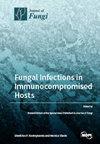通过果实中细胞壁降解酶和成分的变化鉴定 Colletotrichum truncatum 导致 Hylocereus undatus 炭疽病的特征和致病性
IF 4.2
2区 生物学
Q2 MICROBIOLOGY
引用次数: 0
摘要
炭疽病是番木瓜的毁灭性病害之一,严重影响植株生长和果实品质,在全球范围内造成巨大的产量和经济损失。然而,有关导致中国甘肃省番木瓜(Hylocereus undatus)果实炭疽病的病原体种类及其致病机理的信息尚不清楚。因此,我们本研究的目的是根据病原菌的形态和分子特征鉴定引起番荔枝果实炭疽病的病原菌种类,并通过生理生化方法确定其致病机理。本研究从采集到的病株中分离出 46 株病原菌,并根据菌落和分生孢子的形态特征将其分为三种类型(分别命名为 H-1、H-2 和 H-3)。H-1、H-2 和 H-3 型的分离率分别为 63.04%、21.74% 和 15.22%。H-1 型中具有代表性的单孢分离株 HLGTJ-1 具有显著的致病性,根据形态特征和多焦点序列分析,最终确定病原为 Colletotrichum truncatum。此外,与对照组相比,接种了 C. truncatum 的 H. undatus 果实的细胞壁降解酶(CWDEs)纤维素酶(Cx)、β-葡萄糖苷酶(β-Glu)、聚半乳糖醛酸酶(PG)和果胶甲基半乳糖醛酸酶(PMG)的活性显著增加,而细胞壁成分中原果胶和纤维素的含量则有所下降。从接种后第 0 天到第 6 天,Cx、β-Glu、PG 和 PMG 的平均活性分别增加了 30.73%、40.40%、51.55% 和 32.23%。与对照组相比,原始果胶和纤维素的平均含量分别减少了 1.82% 和 16.47%,而可溶性果胶的平均含量则增加了 38.31%。我们的研究结果表明,C. truncatum 感染增加了 H. undatus 果实中的 CWDEs 分解细胞壁成分的活性,最终导致果实腐烂变质。因此,我们的研究结果将为今后控制番木瓜炭疽病提供重要依据。本文章由计算机程序翻译,如有差异,请以英文原文为准。
Characterization and Pathogenicity of Colletotrichum truncatum Causing Hylocereus undatus Anthracnose through the Changes of Cell Wall-Degrading Enzymes and Components in Fruits
Anthracnose is one of the destructive diseases of pitaya that seriously affects the plant growth and fruit quality and causes significant yield and economic losses worldwide. However, information regarding the species of pathogens that cause anthracnose in pitaya (Hylocereus undatus) fruits in Gansu Province, China, and its pathogenic mechanism is unknown. Thus, the purposes of our present study were to identify the species of pathogens causing H. undatus fruits anthracnose based on the morphological and molecular characteristics and determine its pathogenic mechanism by physiological and biochemical methods. In our present study, forty-six isolates were isolated from the collected samples of diseased H. undatus fruits and classified as three types (named as H-1, H-2, and H-3), according to the colony and conidium morphological characteristics. The isolation frequencies of H-1, H-2, and H-3 types were 63.04%, 21.74%, and 15.22%, respectively. The representative single-spore isolate of HLGTJ-1 in H-1 type has significant pathogenicity, and finally we identified Colletotrichum truncatum as the pathogen based on the morphological characteristics as well as multi-locus sequence analysis. Moreover, the H. undatus fruits inoculated with C. truncatum had a significantly increased activity of cell wall-degrading enzymes (CWDEs) cellulase (Cx), β-glucosidase (β-Glu), polygalacturonase (PG), and pectin methylgalacturonase (PMG), while having a decreased level of cell wall components of original pectin and cellulose in comparison to control. The average increased activities of Cx, β-Glu, PG, and PMG were 30.73%, 40.40%, 51.55%, and 32.23% from day 0 to 6 after inoculation, respectively. In contrast, the average decreased contents of original pectin and cellulose were 1.82% and 16.47%, respectively, whereas the average increased soluble pectin content was 38.31% in comparison to control. Our results indicate that C. truncatum infection increased the activities of CWDEs in H. undatus fruits to disassemble their cell wall components, finally leading to the fruits’ decay and deterioration. Thus, our findings will provide significant evidence in the controlling of pitaya anthracnose in the future.
求助全文
通过发布文献求助,成功后即可免费获取论文全文。
去求助
来源期刊

Journal of Fungi
Medicine-Microbiology (medical)
CiteScore
6.70
自引率
14.90%
发文量
1151
审稿时长
11 weeks
期刊介绍:
Journal of Fungi (ISSN 2309-608X) is an international, peer-reviewed scientific open access journal that provides an advanced forum for studies related to pathogenic fungi, fungal biology, and all other aspects of fungal research. The journal publishes reviews, regular research papers, and communications in quarterly issues. Our aim is to encourage scientists to publish their experimental and theoretical results in as much detail as possible. Therefore, there is no restriction on paper length. Full experimental details must be provided so that the results can be reproduced.
 求助内容:
求助内容: 应助结果提醒方式:
应助结果提醒方式:


